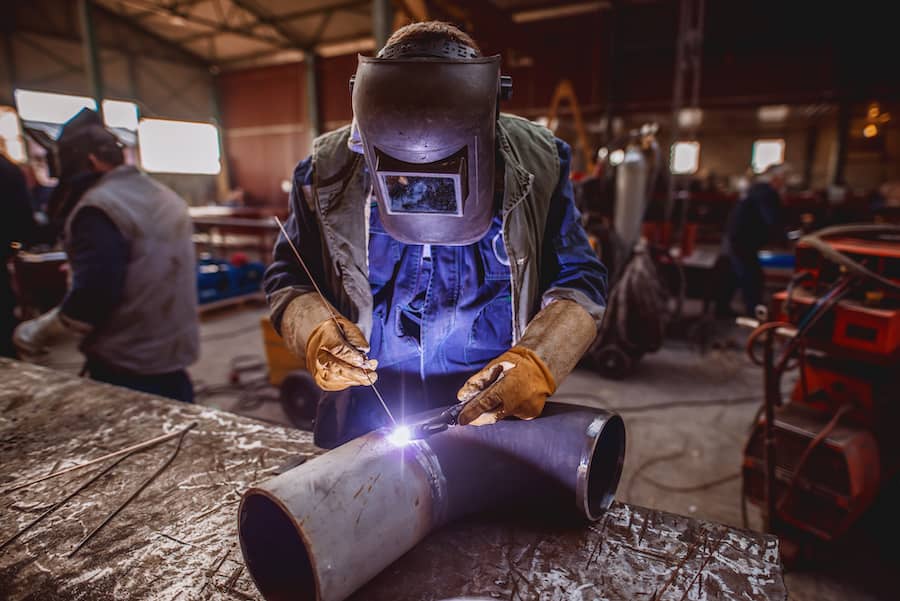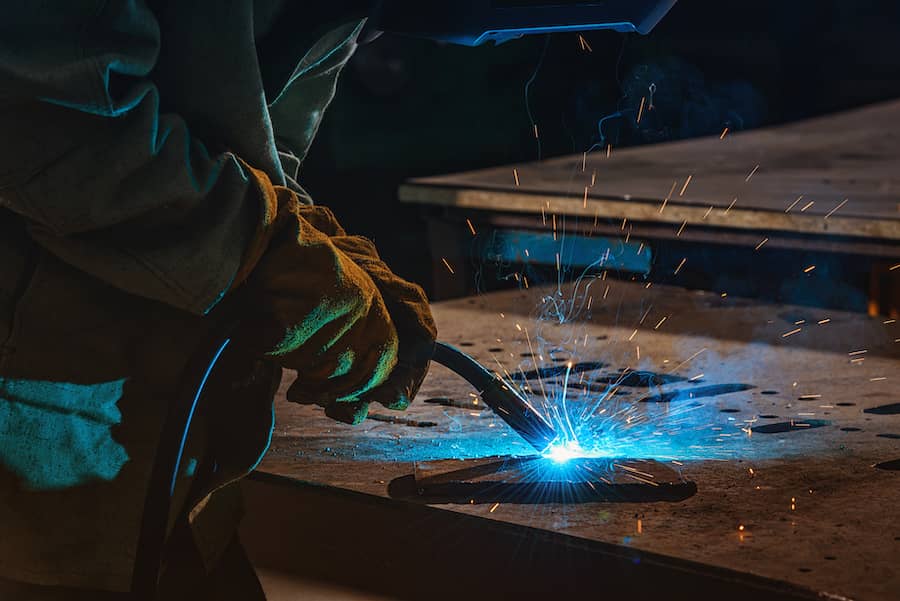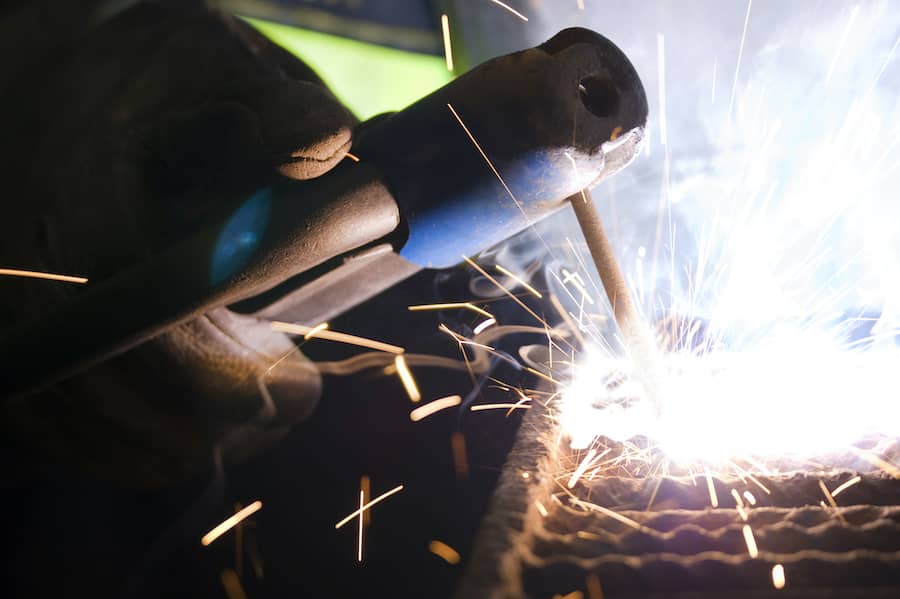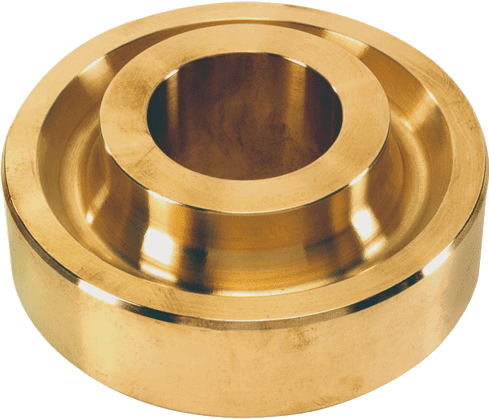What Filler Metal to Use in Welding Dissimilar Metals?
AMPCO METAL
Despite its challenging aspects, welding dissimilar metals is a commonly used process in the construction, oil & gas, automotive, and aerospace industries, to name a few. That is because it helps bring together different metal properties, thus lowering material cost and improving performance. However, in order to have a good weld, it is critical to understand what materials are involved, what your desired welding result is, which welding process is available to you, and what filler metal is required. Otherwise, you might have undesired problems, like poor bonding, cracking, or material failure. Here, we will guide you into the selection of filler metals, or consumables, for your welding process.

What is a filler metal?
A filler metal is a material that melts upon heating to flow in between two adjacent metal workpieces and create a weld joint. It is, generally, an alloyed material with specific melting and flow properties, which can produce a joint that meets service requirements, such as corrosion resistance and mechanical strength. It is basically used or consumed until it becomes part of the created weld.
Not all welding processes require a filler metal, but for the ones that do, filler metals are a fundamental element. These processes are typically under the umbrella of fusion welding. Fusion welding is all welding practices that involve melting of materials to join multiple workpieces together at distinct points. Arc welding, for example, is a type of fusion welding, and it includes a variety of welding techniques that make use of an intermediate filler metal.
When selecting a filler metal, you have to consider the following factors:
- Base materials: what materials do you intend to weld? Check if their chemistry and mechanical properties are equivalent. If their strengths are different, match your filler metal’s strength to that of the weaker material.
- Welding position: the position of your welding can restrict your operation and undermine the welding efficiency. Make sure to select a filler metal versatile enough in terms of type and size.
- Shielding gas: be careful in selecting filler metals compatible with the available shielding gas, especially active gases like CO2 mixtures.
- Design requirements: specify your design requirements before selecting the filler metal. This helps you select a filler metal with the right penetration characteristics and properties.
- Environment: make sure to follow specifications and codes that indicate what filler metal meets the conditions of your end product. This is crucial so that the weld does not corrode or deteriorate, which could lead to weld failure.
- Welding equipment and power: electric current and filler metal should be carefully chosen to avoid undesirable weld spatter and poor weld quality.
- Heat-treatment compatibility: understand your pre-and post-weld heat treatments in order to select a filler metal that responds appropriately to that heat.

How filler metals are used in welding dissimilar metals
Welding dissimilar metals is a solution that answers the need for efficiently compiling good material properties while maintaining reliability and cost-effectiveness. But in order to do that, you have to take into account several considerations, primarily the types of materials involved.
Arc welding processes are useful techniques for welding dissimilar metals, but they require suitable filler metals to create a weld with sufficient bonding strength and corrosion resistance. These processes include gas metal arc welding (GMAW), gas tungsten arc welding (GTAW), shielded metal arc welding (SMAW), and flux-cored arc welding (FCAW). The following sections provide an insight into those welding processes and how the filler metals are employed in each. To see examples of filler metals, check Table 1 below.
Filler metals for GMAW
Gas metal arc welding (GMAW) is a process that makes use of a shielding gas protecting the weld pool from contamination and external factors, such as oxygen. GMAW processes can be classified based on the nature of the shielding gas. If the gas is an inert gas, like argon or helium, the process is more commonly referred to as metal inert gas (MIG) welding. If the gas is a reactive gas, such as carbon dioxide, the process is called metal active gas (MAG) welding.
Both MIG welding and MAG welding utilize a consumable electrode that is initially in the form of a solid wire. This continuous metal wire is passed through the welding gun and brought to contact with the workpiece. Once an electric current is applied, a welding arc is generated, which heats up the metal, causing it to melt and fuse with the base metals. The material that makes up this continuous electrode is the filler metal. Some of the commonly used filler materials are aluminium bronze and copper alloys. They can be used to weld various kinds of metals, including ferrous, non-ferrous, and copper-based materials.
Filler metals for GTAW
Gas tungsten arc welding (GATW) is another arc welding process that uses a shielding gas. In fact, it is also referred to as tungsten inert gas (TIG) welding, where just like MIG welding, it uses a noble gas as the shielding gas. However, it employs a non-consumable electrode made of pure tungsten or tungsten alloy. This electrode comes in the form of a solid wire or rod and, thanks to its high melting point, does not melt under the generated heat. This allows the generated electric arc to burn freely as the welding gun is moved over the workpiece.
For that reason, TIG welding requires a separate filler metal to be held in close proximity to the electric arc so it can heat up, melt, and coalesce with the base metals to create the weld joint. TIG welding is compatible with similar filler metals like those of MIG welding and MAG welding, mainly aluminium bronze.
Filler metals for SMAW
Another commonly used technique for welding dissimilar metals is shielded metal arc welding (SMAW). Also referred to as flux shielded arc welding – or more practically, stick welding – SMAW is a manual welding process. It utilises a consumable electrode without the need for a shielding gas. That is because the electrode is coated with a flux material that can do the shielding job. This basically happens during the welding process, where the flux disintegrates and forms inert gases and a slag that help protect the melt from oxygen.
The filler metal is the material that makes up the consumable electrode, and it can be different grades of aluminium bronze, as well. In fact, some of these filler metals can be overlay filler metals, which act as layers that enhance the properties of corrosion resistance, hardness, and wear resistance.
Filler metals for FCAW
Flux-cored arc welding (FCAW) is a similar technique to SMAW but is distinct in terms of how weld shielding is done. In fact, FCAW was developed specifically to replace SMAW with its automatic/semi-automatic functionalities and its continuous supply of a consumable tubular electrode – comparable to MAG welding.
FCAW uses two types of shielding:
- Self-shielding, where the flux material coating the electrode disintegrates upon heating and generates protective gases and slag.
- Dual-shield welding, where in addition to the flux material’s shielding job, an additional shielding gas is supplied, usually a gas mixture of carbon dioxide and argon.
Such protection allows its use in outside settings, where the risk of contamination and oxidation is higher, such as in maritime applications.
Similarly, filler metals constitute the consumable electrode, and they are usually overlay filler metals as they can provide the necessary oxidation and corrosion resistance to the base materials.

Filler metals and how to find them
Evidently, filler metals have an extensive range of use in terms of welding processes, compatible base materials, and application areas. The table below shows a list of filler metals provided by AMPCO METAL, a leading supplier of engineering metal products. Explore the different materials and their applications.
Table 1. Filler metals for different arc welding processes
|
Filler metal |
Compatible welding processes |
Materials that can be welded |
Application areas |
|
(aluminium bronze) |
MIG welding MAG welding TIG welding SMAW |
Ferrous metals, non-ferrous metals, high-carbon steel, low-carbon steel, copper, bronze, copper-nickel alloys, steel to bronze, cast iron to steel, cast iron to bronze, copper to steel |
Bearings, bushings, pump housings, condenser boxes, hydraulic pistons, brake drums, tractor gear housings, motor bases, tin plate mill rolls, gears, valve seats, press rams, ship propellers |
|
(nickel-aluminium bronze spooled wire) |
MIG welding MAG welding TIG welding SMAW |
Cast nickel-aluminium bronze, wrought nickel-aluminium bronze |
Ship fittings, propeller gear housings, power plant valves, marine propulsion systems, oil recovery pumps, piping systems, ship propellers |
|
(aluminium bronze) |
MIG welding MAG welding TIG welding SMAW |
Copper bronze alloys |
Hydraulic pistons, bearings overlays, impellers, turbine runners, press rams, valve seats, breaker blocks, steel mill rolls |
|
(aluminium bronze, good alternative to beryllium copper) |
MIG welding MAG welding TIG welding |
Wrought copper alloys |
Mould cores, mould pins, repair of blow moulds, injection moulds |
|
(deoxidised copper alloy) |
MIG welding MAG welding |
Deoxidised copper, copper castings, galvanised steel |
Billet moulds, conductor rolls, heater elements, copper sculptures, copper connectors, bus bars |
|
(aluminium bronze flux core wire) |
MIG welding MAG welding SMAW FCAW |
Copper bronze alloys |
Gear teeth Friction plates Pump shafts Bearings high-speed bearings Stripper columns Sliders Wear plates |
|
(aluminium bronze flux core wire) |
MIG welding MAG welding SMAW FCAW |
Copper bronze alloys |
Friction plates Bearings, high-speed bearings Sliders Forming dies |
|
(nickel-aluminium bronze metal core wire) |
MIG welding MAG welding FCAW |
Aluminium bronze Ferrous metals |
Shafts Guide grooves Marine applications Overlaying steel parts without a buffer layer |
|
(aluminium bronze flux core wire) |
MIG welding MAG welding SMAW FCAW |
Ferrous metals, stainless steel, low-carbon steel, medium-carbon steel, titanium |
Ferrous dies, forming or drawing titanium, fabricating new rebuilding of worn parts |
AMPCO METAL has long been providing engineers and customers with suitable materials, and they continue to do that here through Matmatch. You can further your search options by exploring AMPCO METAL’s wide range of materials listed on our platform.
You can also get in direct contact with them for more information by visiting the AMPCO METAL supplier page.
Artikel von <a href=/suppliers/ampc-ampco-metal> AMPCO METAL </a>AMPCO METAL
AMPCO METAL, headquartered in Switzerland, is a leading international manufacturer and integrated distributor of specialty copper alloys and engineered products.
The company was founded in 1914 in the USA, as an innovator in the introduction and application of aluminium bronze alloys.
It has also introduced to the market several new metallurgical and process techniques that have made AMPCO METAL the recognized quality leader in specialty bronzes and copper alloys.
Over the years, AMPCO METAL has served customers throughout the world in a variety of applications seeking wear, corrosion-resistant and high conductive properties.
Major industries served include: chemical and petroleum, machine tool, primary metal producers, transportation and a wide range of industrial and commercial machinery.
To obtain unique and consistent alloy characteristics, AMPCO METAL utilizes some of the most advanced equipments in the industry, a highly skilled engineering staff and sophisticated quality control procedures.
This allows AMPCO METAL to offer superior lot-to-lot consistency for predictable results.Conscious of the environment, AMPCO METAL utilizes advanced technology throughout its plants and service centers to rigidly maintain clean air and water programs.
AMPCO METAL manufactures a wide range of alloys in a variety of grades and conditions and distributes them through its worldwide network of service centers. This enables AMPCO METAL to work closely with its customers to produce specialty alloys with the properties and characteristics they need.
A century of engineered excellence
Since 1914, AMPCO METAL has worked with industry partners across the Aerospace, Automotive, Steel & Titanium industries, as well as Marine, Oil, Gas & Chemical, along with and a host of others., across a range of applications, including friction & wear, corrosion resistance and heat & electrical conductivity. This unparalleled experience, combined with our technical expertise and engineered alloy excellence mean we’re able to be a global partner in creating metal solutions for our customers.
Superior Casting
Introducing MICROCAST®, our patented high-performance aluminium bronze and specialty copper alloy production technology that delivers the most uniform grain size with the most outstanding wear resistance.

AMPCO®Aluminium Bronze
- A highly polishable, high-strength and better alternative to brass with better grain.
- Higher mechanical properties without lead and cleaner trace elements.
- High wear characteristics and corrosion resistance.
- Best movement material for sliding, motion and typical wear parts with friction problems.
- Recommended for how to solve cavitation problems, galling, tooth flank damage, avoiding nickel contamination and surface problems on stainless steel.
Aluminium bronzes are part of a copper alloys family containing aluminum as their principal alloying element. The properties of these alloys are governed by the properties of copper and aluminium when melted and casted together in rigorous and well-controlled processes.
Aluminium is soluble in copper up to about 8 wt%. This solution is characterized by a homogeneous single alpha phase which displays high ductility and excellent corrosion resistance by forming a protective skin of aluminum oxide on the surface. When increasing the aluminium content, a second phase forms in the microstructure known as the beta phase. These alloys are harder than a single alpha phase, with higher strength and higher mechanical properties.
Other alloying elements can be used like nickel to further improve the resistance to corrosion and mechanical properties. These alloys are used in highly-loaded construction parts that can be exposed to aggressive corrosion environments.
AMPCO METAL was a pioneer in developing aluminium bronze alloys and continues to engineer premium products for critical applications with its well-known AMPCO® product line to this day. Our high-quality, high property and uniquely hard metal range is trusted the world over for its broad use. AMPCO® Aluminium Bronze even extends to food-approved applications through alloys such as AMPCO® 8, AMPCO® 18 and AMPCO® M4.
AMPCOLOY®High Copper Alloy
- A polished hard version copper alloy without coating or lead and clean trace elements
- Best material for injection moulding and welding, with the highest thermal conductivity for mould problems.
- An alternative to Wolfram cathodes for cathode welding material.
- Increases productivity of plastic injection while decreasing their cycle times.
- Also used when food approval is required.
AMPCOLOY® High Copper alloys are engineered with exceptional conductivity, high strength and unique wear characteristics, delivering higher lifetime, quality and performance, with cleaner trace elements. Copper has a face-centered cubic lattice, allowing it to have good cold working properties in addition to high electrical and thermal conductivity. With the addition of carefully selected alloying elements in well-defined proportion, high copper alloys develop the necessary strength and hardness properties with little decrease in electrical conductivity. These material are used in critical applications where both conductivity and mechanical properties are required.
With over a century of expertise, AMPCO METAL and its AMPCOLOY® product line are synonymous with premium quality for critical applications.
AMS Alloys
- Technically specific AMS bronze is used for parts and landing gear.
- Sometimes referred to as aerospace bronze.
AMS alloys are the results of carefully selected alloying elements, well-documented manufacturing processes and specific heat treatment parameters, achieving quality and performances that critical applications like the aerospace industry require.
Standard Alloys
- Offers high flexibility in value, size, and shape.
Standard Alloys continue the AMPCO tradition of excellence in engineered alloys, offering a premium product that can offer performance for demanding applications.
Other Alloys
- Often considered as an alternative to aluminum bronze.
Our high-strength, durable AMPCO® Alloy range and bearing material, recognized for its unparalleled ability to perform under temperature. It’s created through a patented manufacturing process that gives it greater corrosion-resistant properties for a number of specific applications.


